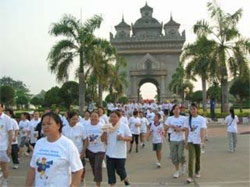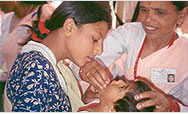Avian and Pandemic Influenza Preparedness and Response: Key Actions to Date
| |
 |
|
|
|
 |
| |
Participants march in an event organized by the Laos Women’s Union (LWU) in Vientiane, Laos, to show their support in the fight against avian influenza. Several officials, including governors of districts affected by outbreaks, participated in the event. USAID has provided assistance to local organizations such as LWU to help educate community members about the disease, and has also launched mass media campaigns to generate more awareness. Source: Academy for Educational Development |
|
|
|
|
|
|
To minimize the avian influenza (AI) impact and pandemic threat, USAID has obligated $468 million in grants and technical assistance for avian and pandemic influenza (API) activities. Of these funds, $33 million and $112 million support activities with the World Health Organization (WHO) and the U.N. Food and Agriculture Organization (FAO), respectively; $169 million is directly invested through bilateral programs in Asia and the Near East; $25 million is directed to Europe and Eurasia; $34 million is supporting AI prevention, response, and pandemic planning in Africa; and $12.5 million supports API activities in Latin America and the Caribbean. Additionally, USAID manages a $56-million commodity stockpile that includes non-pharmaceutical goods such as decontamination equipment and personal protective equipment (PPE) for surveillance and outbreak response workers.
USAID’s API interventions focus on six key areas: planning and preparedness, disease surveillance and case detection, communications for public awareness, commodity stockpiling, emergency outbreak response, and pandemic planning for humanitarian response.
- Planning and preparedness
In collaboration with WHO, FAO, and other partners, USAID provids support to help host-country goverments develop and strengthen national AI task forces and preparedness plans.
- Surveillance and case detection
To ensure rapid detection of AI outbreaks, USAID and its partners have made significant investments to improve disease surveillance and diagnostic capacities in affected and at-risk countries. In Indonesia, for example, USAID supports a community-based surveillance approach and has mobilized participatory disease surveillance and response (PDSR) teams in 331 districts across 27 provinces in Indonesia to visit villages and collect essential surveillance data. This approach contributes to a timely surveillance system and supports a community-based response to control AI. A total of 2,112 PDSR officers have been trained and have worked with over one million community members across Indonesia to strengthen AI surveillance and response.
USAID also works with partners through the Global Avian Influenza Network for Surveillance (GAINS) to increase surveillance of wild migratory birds and track the movement of AI. GAINS contributors work in 34 countries, and more than 40,000 samples have been collected through GAINS efforts for H5N1 analysis. Census data from nearly 105 million bird observations are being made available via an open database and mapping system. Data gathered in surveillance activities increase the availability of scientific information about the H5N1 AI virus, including whether genetic changes that could increase its threat to humans have occurred. The data are also applied to support early-warning systems, which help notify at-risk countries about the movement of AI and its potential spread.
- Communications
USAID supports communications and public outreach activities to generate awareness about API and promote behaviors that help reduce risks for disease transmission. These efforts include both mass media campaigns and community-level outreach to rural populations. In addition, USAID supports trainings for journalists on API reporting.
- Commodities
Since January 2006, USAID has built a stockpile of non-pharmaceutical commodities, including 1.5 million PPE kits (containing protective suits, goggles, gloves, masks, and other supplies to protect first responders from contracting or spreading AI) and 15,000 decontamination kits for use in API surveillance, outbreak investigation, and emergency outbreak response and containment. To date, USAID has delivered nearly 550,000 PPE kits to 78 countries, and more than 30 percent of decontamination kits have been deployed. In March 2008, USAID launched a regional stockpile warehouse in Southeast Asia housing 50,000 sets of PPE and 400 decontamination kits for use in outbreak investigation and response.
- Outbreak response
USAID has worked with partners to help strengthen animal and human AI response efforts. Activities include promotion of safe culling and disposal procedures and improved biosecurity practices in poultry-raising settings. USAID also supports trainings for first responders in AI-affected countries on the proper use of PPE, how to collect and ship samples, and how to detect AI using improved laboratory equipment. In Indonesia, USAID supports the efforts of participatory disease response teams, which use critical disease information supplied by the community-level participatory disease surveillance teams to quickly identify poultry infections and work with farmers and local governments to implement rapid response and containment measures during outbreaks.
- Pandemic planning for humanitarian response
USAID is currently scaling up its pandemic planning and humanitarian response activities [PDF, 83KB] and is working with a coalition of United Nations organizations and NGOs to support up to 25 countries in developing comprehensive plans and capacity for management of a humanitarian response in the event of a global influenza pandemic.
Latest News and Resources
Related USAID Programs
Additional Information on Avian and Pandemic Influenza
|


